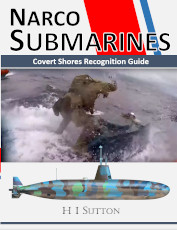

![]()

Guest article by C. Edward Davis
Stalin's Robot submarines
 Midget submarines, those vessels with an underwater displacement of between 100-150 tons, have been considered essential assets in many navies engaged in underwater intelligence gathering and covert missions into enemy territory. This type of vessel can trace its origins as far back as the mid-19th century. By the 1930’s, midget submarine development was undertaken by most of the navies of the world, preparing for the eventual start of global war. The leaders of midget submarine development were Japan, Germany and Italy. Few history enthusiasts are aware that the Soviet Union was also engaged in this arena of naval development. This is understandable as the Soviet Union’s war was fought mainly on land and in the air.
Midget submarines, those vessels with an underwater displacement of between 100-150 tons, have been considered essential assets in many navies engaged in underwater intelligence gathering and covert missions into enemy territory. This type of vessel can trace its origins as far back as the mid-19th century. By the 1930’s, midget submarine development was undertaken by most of the navies of the world, preparing for the eventual start of global war. The leaders of midget submarine development were Japan, Germany and Italy. Few history enthusiasts are aware that the Soviet Union was also engaged in this arena of naval development. This is understandable as the Soviet Union’s war was fought mainly on land and in the air.
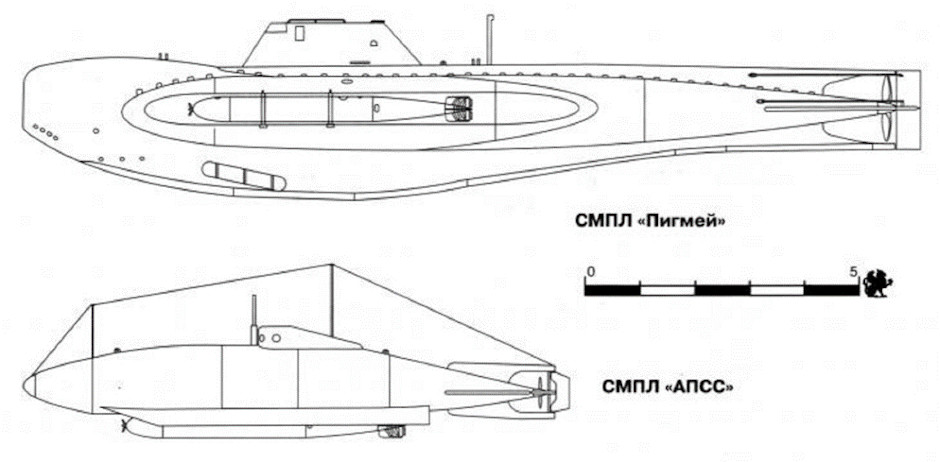
The products of the OstekhBureau, the SMPL “Pygmei” (top) and the SMPL APSS, robot submarine (bottom). (Source: Internet)
In Soviet Navy parlance, midget submarines or ultra-small submarines (Sverkhmalyye Podvodnyye Lodki (SMPL)), were sometimes referred to as “dwarf” (karlik) submarines, and the development of this unique class of vessels began, in earnest, in the mid 1930’s. Several design bureaus were involved, among them the TsKBS-1, Central Shipbuilding Design Bureau (Tsentral'noye konstruktorskoye byuro sudostroyeniya) and the Special Technical Bureau for Military Inventions of Special Purpose (Spetsial'noye tekhnicheskoye byuro voyennykh izobreteniy spetsial'nogo naznacheniya or OstekhByuro or OTB), the particular subject of this article. We will discuss, briefly, the other SMPL projects at the end of this article. For now, we are concerned with the very unique designs of the OTB – the APSS and APL Pygmy.
Get The essential guide to World Submarines
This Covert Shores Recognition Guide Covers over 80 classes of submarines including all types currently in service with World Navies.Check it out on Amazon
On 18 July 1921, the Special Technical Bureau for Military Inventions of Special Purpose was formed in Leningrad under the direction of Engineer Vladimir Ivanovich Bekauri. Bekauri was joined by Academicians V. N. Ipatiev and Vladimir Fedorovich Mitkevich and Professors M. M. Tikhvinsky, V. S. Ignatovsky and V. I. Kovalevsky. The OstekhBureau was tasked with the development of radio-controlled weapons such as remotely-detonated land mines, radio-controlled tanks and torpedo boats, radio-controlled long-range aircraft and other systems that were rather technically advanced for the period.
In 1934, a special design group known as the 1st Department, was established specifically to pursue the development of ultra-small, radio-controlled submarines. The department was placed under the direction of Engineer K. V. Starchik (or Fedor V. Shchukin – translated documents do not make this entirely clear).
Two SPL’s were under development: the Aero-podvodnyye Samodvizhushchiysy Snayad or Aero-underwater Self-propelled Projectile or APSS and the Sverkhmalaya Podvodnaya Lodka Pigmei or SPL Pygmy, the subjects of this essay.
SMPL APSS
The OstekhBureau’s initial project was the APSS, which was an ultra-small, radio-controlled submarine. Design work began in 1934, under Shchukin, with Starchik as the lead designer (as stated before, translated documents do not make this very clear). The APSS was referred to by a variety of designations, according to modern translated Russian documents, such as Autonomous Submarine Special Vessel; Telemechanical Submarine; and Tele-controlled Self-propelled Projectile.
The APSS was a very small, robotic vessel (at least initially) weighing 7.9 tons (15,873 lbs.), 32.8 feet (10 meters) long with a beam of 4.1 feet (1.25 meters). It was planned to operate at a depth of no more than 33 feet (10 meters). Its underwater speed was estimated at 4.5 knots (5.2 mph). Armament was varied, depending upon the mission: a 457 mm (18 inch) torpedo (referred to in translated documents as a “1912 model” – the exact nature of this phrase is not clear) mounted externally between the double-keels, or a 794 lbs. (360 kg) explosive charge with a “proximity fuse” (possibly a reference to a magnetic detonator) in a removable bow compartment.
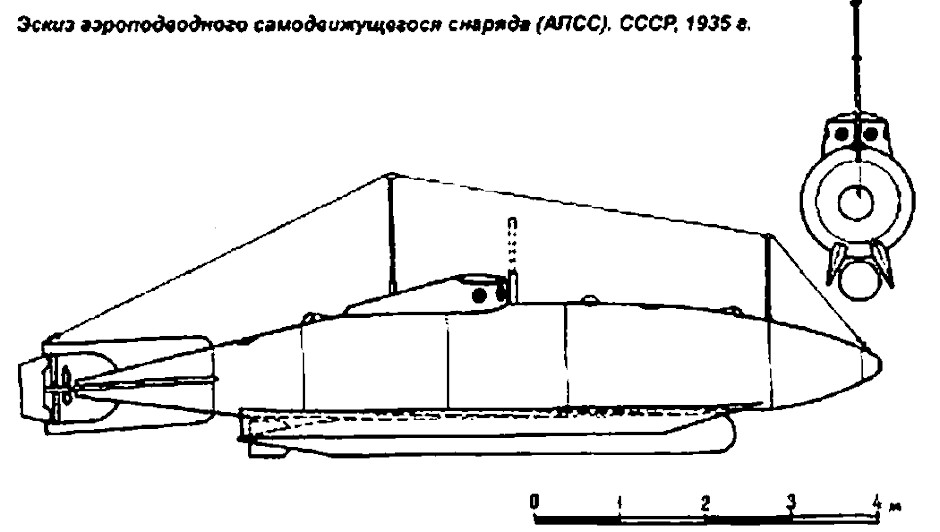
Starboard side and bow views of the SMPL APSS, robot submarine, circa 1935. (Source: Internet)
Structurally, the APSS was relatively simple: a cigar-shaped metal hull (either riveted or welded, see below) with dual external keels and divided into five compartments. The first compartment housed the explosive charge (or possibly when equipped with a torpedo, this compartment would contain ballast). The second compartment contained 33 battery cells (referred to in translated documents as “half-battery cells”) and part of the auxiliary radio control equipment. The third compartment or central compartment, not too surprisingly when considering the state of Soviet electronics in 1934, contained the pilot’s compartment (referred to as the “manual control post”). This included the pilot’s seat, steering and diving controls, ballast controls and a periscope that extended 26 inches (65 cm) above the hull (it is unlikely that the periscope was made to retract due to the small space available in the 3rd compartment). The pilot sat beneath a small cupola or wheelhouse fitted with four glass windows and an access hatch. This compartment would have been quite crowded for even the smallest pilot as it also housed the main components of the tele-control system, ballast tanks, compressed air bottles and the torpedo controls.
The fourth compartment housed 24 battery cells (again, “half battery cells”) and the pneumatic steering gear for the tele-control system. It was not stated whether the manual controls were likewise pneumatic or were mechanical in nature.
The fifth and final compartment contained the propulsion system. This comprised a 10.9 hp (8.1 kW) DC electric motor driving a single propeller on a short shaft. The propeller had at least two blades, but the total number of blades is unclear in the photographs.
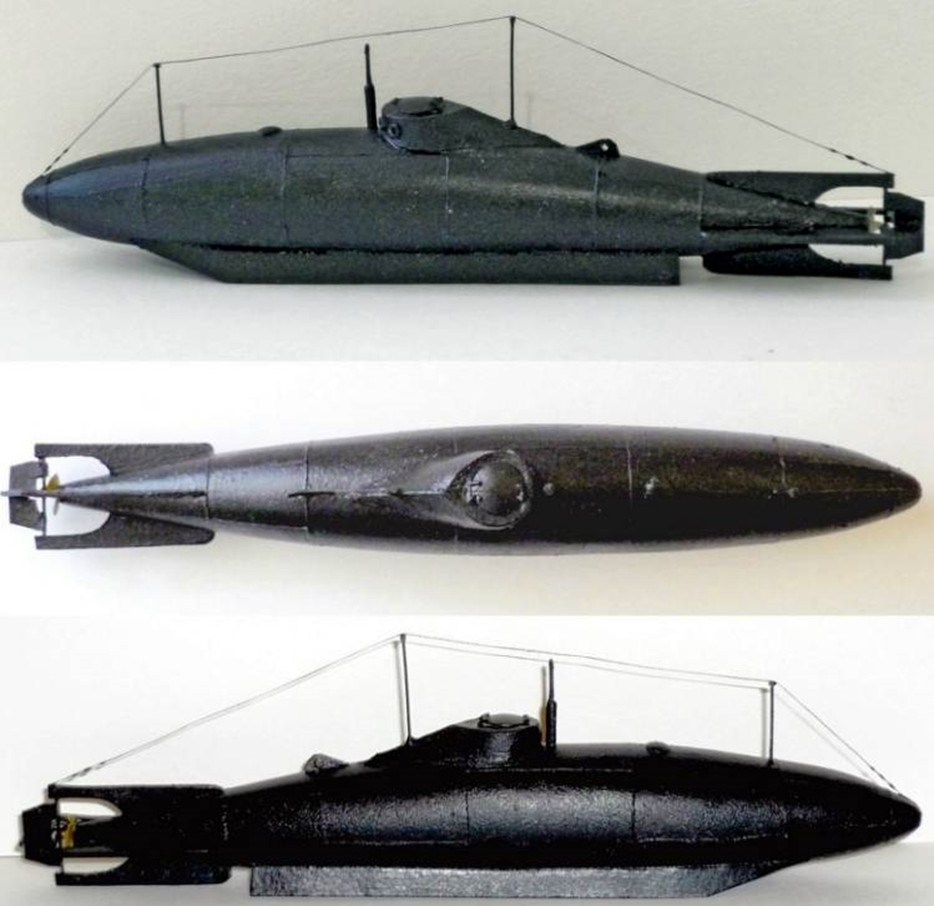
Photographs of a model of the SMPL APSS, robot submarine. (Source: https://en.topwar.ru/155979-bespilotnye-podvodnye-lodki-stalina.html)
The stern featured a cruciform tail, with four long fins, a separate rudder, and diving planes.
Within the double keels were four cylinders (2 per keel?) carrying 14.4 gallons (62 liters) of compressed air for the ballast tanks and control system. Between these keels were lugs for the external torpedo.
Two radio control antennas were mounted outside the hull. The first was mounted between the 1st and 2nd compartment and the second on the wheelhouse aft fairing. These were connected to each other by lead wires that terminated at the aft end of the dorsal fin.
Two methods of tracking the APSS were used. On the top of the hull, above the 2nd and 5th compartments, were powerful lamps aimed upwards. These would be used to identify and observe the weapon at night (and would also give away the weapon’s position if used operationally).
THE book on Special Forces subs Covert Shores 2nd Edition. A world history of naval Special Forces, their missions and their specialist vehicles. SEALs, SBS, COMSUBIN, Sh-13, Spetsnaz, Kampfschwimmers, Commando Hubert, 4RR and many more.
Check it out on Amazon
The second method was installed either in the 4th or 5th compartment, the exact placement of the device on or within the hull is unclear. It was a device that would eject a quantity of fluorescent green dye into the water. This was specifically used for tracking the APSS during daylight operations.
In addition, an emergency buoy with an electric lamp and telephone was installed forward of the wheelhouse. Whether this was planned for operational variants, manned or unmanned, or simply for engineering trials is also unclear.
As the APSS was planned to be carried to the operational area via aircraft, suspension lugs were mounted above the 2nd and 5th or 4th compartments and were spaced 16 feet (4.9 meters) apart.
Control of the APSS was through encrypted radio signals, transmitted from either the carrier aircraft or a surface vessel. VHF signals were to be used while the APSS was on the surface and UHF would be used while submerged.
As noted before, the method of deployment was unique to the APSS project. The “A” in APSS stood for “aero”, thus the weapon was to be deployed from a carrier aircraft. For this purpose, the chosen aircraft was the Tupolev ANT-22 or MK-1, twin-fuselage flying boat. First flown in August 1934, it was powered by six Mikulin M-34R twelve cylinder, water-cooled, in-line Vee engines of 820 hp (612 kW) each. The aircraft was grossly over-weight for the power available and was abandoned after only one example was built. Range of the ANT-22 was estimated at 311-373 miles (500-600 km). One or two APSS’s were to be carried. It is not stated whether the unmanned APSS would be air-dropped or the carrier would land on the water, then deploy the weapon. Control would be from a special cabin aboard the carrier aircraft or warship, if so deployed.
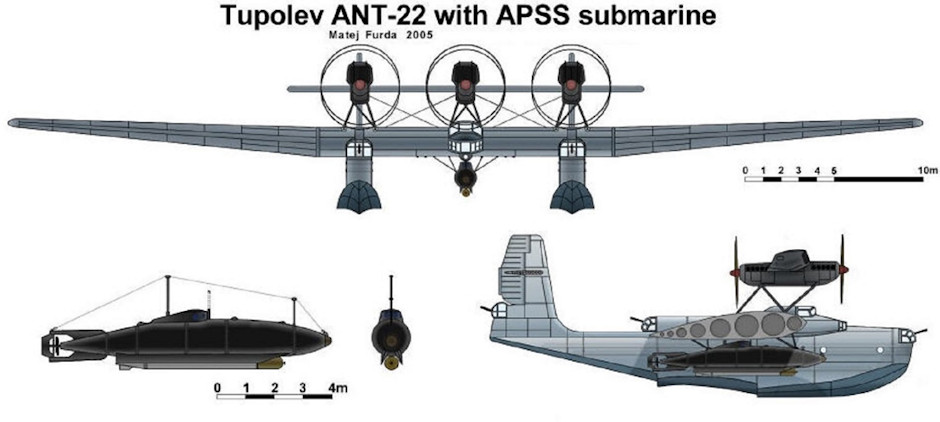
Drawing of the Tupolev ANT-22 with an APSS SMPL mounted beneath the central fuselage. (Source: https://weaponews.com/weapons/65349017-unmanned-submarines-stalin.html)
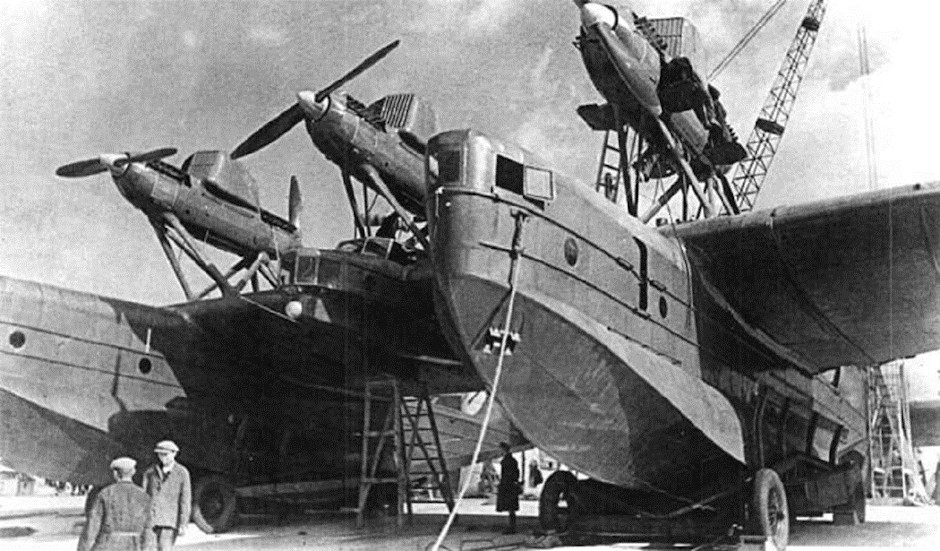
The size of the Tupolev ANT-22 is readily apparent in this photograph. (Source: https://www.globalsecurity.org/military/world/russia/ant-22-pics.htm)
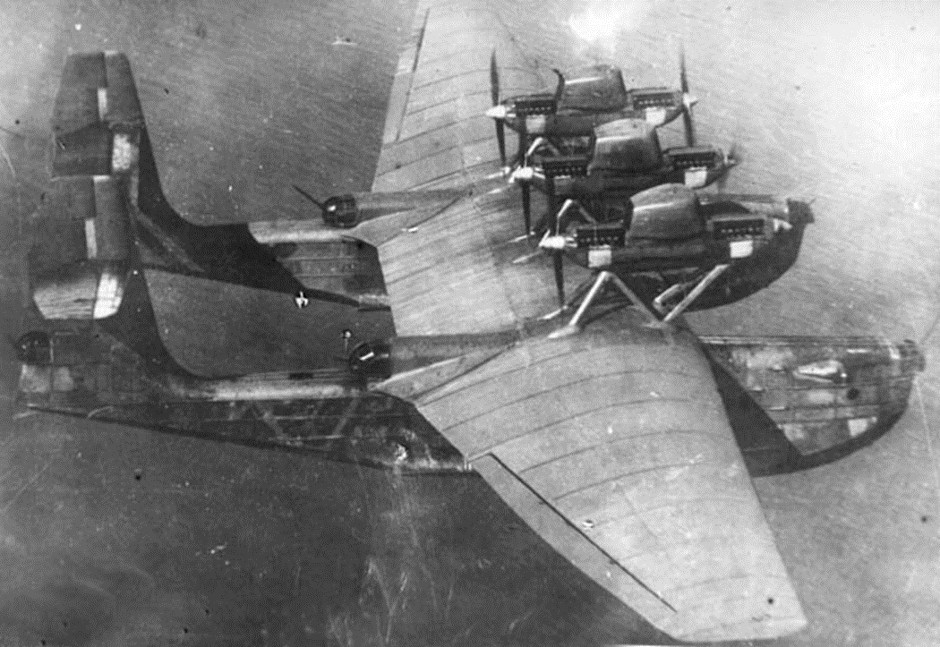
The Tupolev ANT-22 during flight trials in 1934. The aircraft proved to be grossly underpowered for its size and this led to the aircraft’s abandonment. (Source: https://en.wikipedia.org/wiki/Tupolev_ANT-22)
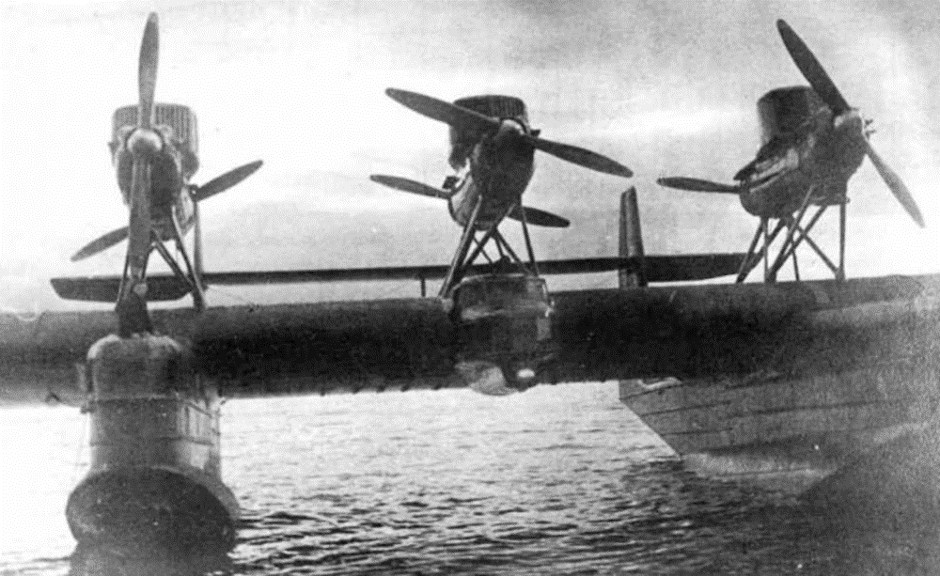
This view of the Tupolev ANT-22 clearly shows the central nacelle with the pilots’ cockpit. Beneath this nacelle, the APSS would have been carried. (Source: https://en.topwar.ru/160878-mk-1-shestimotornyj-gigant-tupoleva.html)
Two examples of the APSS were built between 1935 and 1936 at the Sudomekh Shipyard No. 196 in Leningrad. One APSS, assembled in 1935, had a riveted hull. The second example, completed in 1936, had a welded hull.
Factory testing results were very disappointing and the submarine was deemed unacceptable for service trials. Further manned tests of the APSS were cancelled. Prior to the German invasion of 1941, both hulls were scrapped.
SMPL APL “Pigmei”
The second ultra-small submarine design undertaken at the OstekhBureau was the Aero-podvodnyye Lodki or APL. Initially, this vessel was conceived as a radio-controlled submersible, also launched by an aircraft (assuming the Tupolev ANT-22 or modified variant). However, the dismal trials of the APSS dictated a redesign to a fully manned vessel.
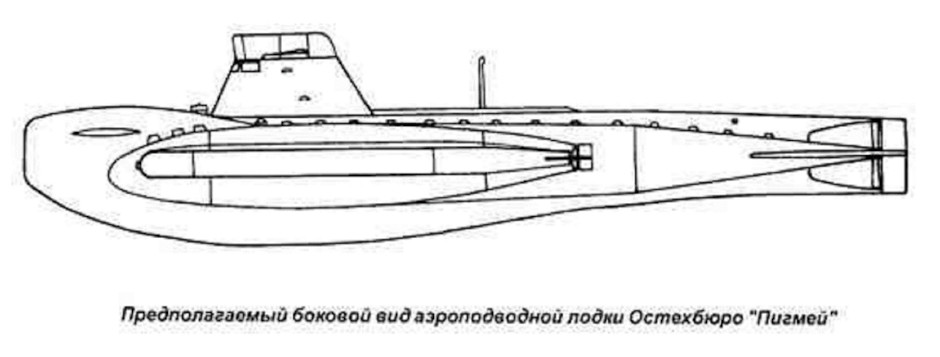
Another scale drawing of the SMPL “Pygmei”. (Source: http://www.deepstorm.ru/DeepStorm.files/17-45/apl/list.html)
Designed by a team led by F. V. Shchukin, the APL was also constructed at Sudomekh Plant 196 in Leningrad. The APL would be crewed by four men, displaced 18 tons (36,000 lbs.) and was powered by a 24 hp (18 kW) diesel engine on the surface and an electrical motor (output not stated) for submerged running. As in all diesel-electric submarines, the batteries for the electrical motor would be charged by the diesel while on the surface. The 24 hp diesel engine was later replaced with a 36 hp (27 kW) engine.
Detailed information on the construction of the APL is, as yet, unavailable. We can assume that its structure and construction were comparable to other Soviet submarine constructions of the period.
The World's ONLY Guide to
Narco Submarines
10 years of research, analyzing over 160 incidents, condensed into a handy guide. This unique book systematically breaks down the types and families. With detailed taxonomy, recognition 3-views, profiles and photos. Available on Amazon
In August 1935, the completed APL (with the 24 hp engine) was shipped by rail to the testing facility at Oranienbaum (or Lomonosov), known as the former Czar’s royal residence, located 14 miles (23 km) west of Leningrad and almost due south of Kronshtadt Island, in the Gulf of Finland. Several trial runs were made into the Gulf and these test were, according to translated documents, “more or less successful”. I will assume that means the boat didn’t sink! Still, the People’s Commissar of Defense considered the results promising enough to order ten “improved” APL ultra-small submarines, with the first six to be delivered sometime in 1936. However, the manager of Plant 196 refused to start construction of the APL until the vessel completed its service trials and all deficiencies were identified and corrected. One wonders what happened to that manager defying orders like that in Stalin’s USSR.
Engineers Shchukin and Shebalin worked diligently to correct the initial deficiencies, such as the underpowered diesel engine, the electric motor (this author will assume that this was also underpowered), the batteries and other equipment. The original 24 hp diesel engine (type and model not identified) proved to run extremely hot and its unmuffled exhaust could be heard for miles. Not exactly a preferred feature for a small submarine employed on covert missions!
After the trials at Oranienbaum, the APL was loaded on a rail-car and delivered to the OstekhBureau test facility at Sevastopol, the Sevastopol'skiy morskoy zavod or Sevastopol Marine Plant in the Crimea. There the Soviet Navy trials would be conducted that November. The commander of the APL for its service trials was Senior Lieutenant B. A. Uspensky from the 1st Submarine Brigade of the Black Sea Fleet . He was assigned the task on 19 August 1936. The APL received the designation OS or Op’tnoyye Sudno or Experimental Vessel and was classified as top secret by the 1st Submarine Brigade’s commander, G. V. Vasiliev. The APL was now known as the “Pigmei” or Pygmy.
The trials began in October 1936, but were never completed. Uspensky himself reported to the Chief of Naval Forces in December 1936, that no further tests should be conducted. He is reported as writing: “The living conditions on the boat are extremely difficult.” Diesel exhaust fumes contaminated the air; a structural “mismatch” between the electric motor and propeller shaft resulted in severe vibrations; the magnetic compass was installed too close to power cables and gave a reading 36-degrees off; the diesel engine , a one-off experimental model, ran exceedingly hot and was excessively noisy, as noted above, and emitted large, noticeable plumes of exhaust smoke; the electrical motor, so essential for submerged operations, burned out after a few underwater runs.
In addition, the Pygmy’s torpedo system tests, comprising two 457mm torpedoes in external racks on the side of the hull, were disastrous. When the first torpedo was launched, it failed to arm and was lost at sea. The second torpedo launch almost sank the submarine! Immediately after launching, the torpedo veered sharply and its tail struck the hull. This bent the tail assembly and it began running in circles. It nearly collided with the submarine on its first orbit. Fortunately for the crew, the torpedo continued circling farther and farther away until it, too, sank.
Despite these near disasters, Plant 196 was compelled to begin construction of the APL. However, even before the first metal could be cut, on 11 October 1937, Engineer Shcheglov stated before a review committee that there was a plan to equip the production version of the Pygmy with “bubble-free, tubular torpedo tubes that would require a 16 inch (400mm) extension of the hull.” This was never to be as not a single Pygmy was completed.
Unresolvable technical and construction problems resulted in the project’s cancellation. Managers in Stalin’s ultra-repressive Soviet Union did not simply cancel projects and get off with a stern reprimand. In Soviet eyes, someone had to pay for the failure of a project regardless of the reason. Sometimes this was considered sabotage or anti-Soviet treachery. In early 1938, the NKVD (the predecessor to the more familiar KGB) arrested almost all of the OstekhBureau’s upper managers. Bekauri and Shchukin were both tried and executed. Both men were eventually “rehabilitated” in 1956. The entire OstekhBureau was disbanded in 1939 and the surviving managers, engineers, technicians and workers were reassigned to other bureaus.
The Pygmy was never listed in the Soviet Navy’s list of equipment. The only example of the submarine was shipped to the Sudostroitel'nyy Zavod “More” at Feodosia, Crimea, 96 miles (155 km) to the east. It was here, in the summer of 1942, that the sole Pygmy fell into German hands.
Submariners from the Regia Marina’s (Royal Italian Navy) famed 10th Flotilla (aka the Decima MAS), experts in midget submarine technology and operations, inspected the Pygmy at Feodosia and were unimpressed. They reported that its design and construction were unequal to the current CB-class midget submarines currently operating out of Romanian ports. The Germans were equally under-whelmed.
Specifications
Length: 52 feet 6 inches (16m)
Beam: 8 feet 6 inches (2.6m)
Displacement: 37,200 lbs. (18.6 tons)
Speed: 6 kts (11 kmh)
Range: 290 miles (467 km)
Maximum Depth: 98 feet (30m)
Crew: 4
Armament 2 x 450mm (18 inch) torpedoes mounted externally, 1 x 7.62mm (.30-cal) gun
Aftermath
When the Crimea was liberated in May 1944, there was no sign of the Pygmy. This has led to some interesting speculations concerning the submarine’s final disposition. Controversy about this remains unsolved to this day.
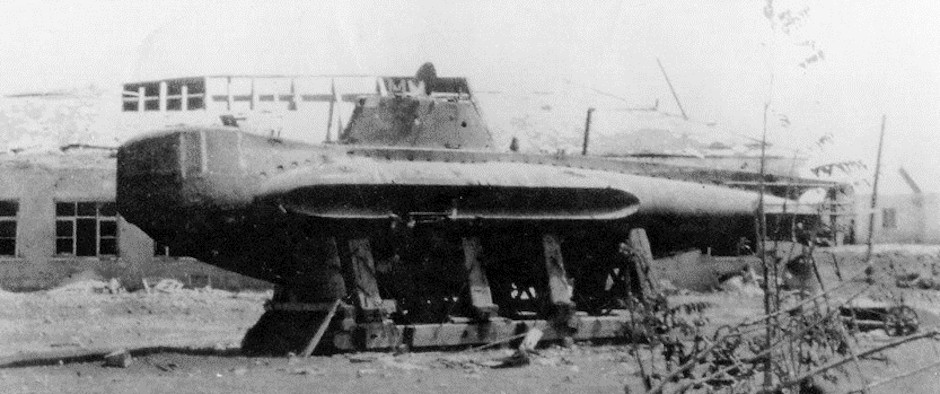
The SMPL “Pygmei”, seen here at the Feodosia shipyard in Crimea when it was examined by specialists from the Regia Marina’s 10th Flotilla or Decima MAS in 1942. (Source: https://topwar.ru/155979-bespilotnye-podvodnye-lodki-stalina.html)
It has been speculated that the Pygmy was being shipped by sea either to Germany or Italy for further examination or simply as a war prize. No documentary evidence exists of this. One hypothesis states that the Pygmy sank along with its transport vessel, or under tow, in the vicinity of Feodosia or Alupka, about 8 miles (12.6 km) southeast of Yalta.
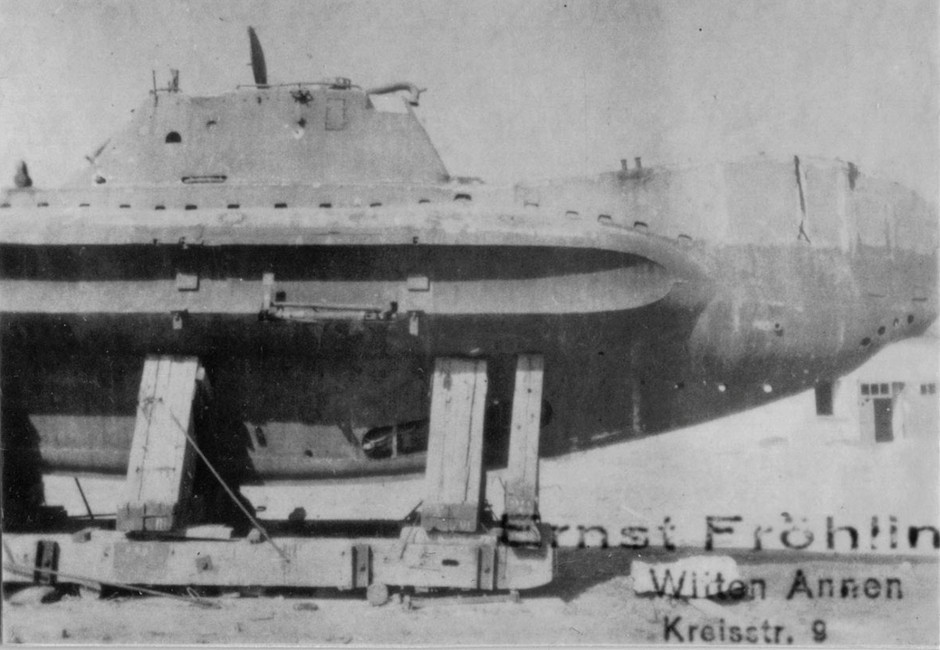
Close-up of the bow of the “Pygmei” SMPL examined by German and Italian experts at Feodosia, Crimea in 1942. Note the large vertical crack in the bow. (Source: https://topwar.ru/155979-bespilotnye-podvodnye-lodki-stalina.html)
After the war (date unstated in translated documents), an unidentified underwater archaeologist reported that TWO midget submarines were discovered off the coast of Feodosia. As there was only a single example of the Pygmy built and present at Feodosia during the war, it would be extremely odd that TWO midget submarines were discovered. ONE could be the Pygmy, but not both. The identity of the second midget submarine could be a Romanian-operated CB-class midget submarine , but this is considered unlikely. There was a Romanian-operated CB-class midget submarine sunk in June 1942 by a Soviet torpedo boat. It was sunk near Yalta, so possibly close to Alupka.
We may never know the truth. But somewhere in the depths of the Black Sea, lies the Pygmy.
Contemporaries of the APSS and APL
In 1936 a government commission issued requests for submissions for an ultra-small submarine or Sverkhmalyye Podvodnyye Lodki (SMPL). The requirement included that the SMPL needed to be able to be transported by rail, small freighters and naval vessels and to be able to be carried by the new K-class cruiser submarine, then under development . Each K-class submarine cruiser was designed to carry a single light aircraft or midget submarine. Only the APSS and APL were required to be carried by an aircraft.
Four submissions were received by the commission: the Moskito; the Blokha (flea); and the APSS and Pigmei, both from the OTB. No details are currently available about the Moskito design, but this author hopes that readers will help fill in some blanks, and provide information for a future article.
The Blokha design was more of a submersible torpedo boat designed by the engineers at TsKBS-1. This design appears to be rather simple in nature and was to be mounted on swing-out davits on Soviet warships. Two blokhi would be carried by the Project “X” Large Cruiser project then under development. This was a very large vessel, carrying up to nine floatplanes, making it a hybrid seaplane carrier-cruiser.
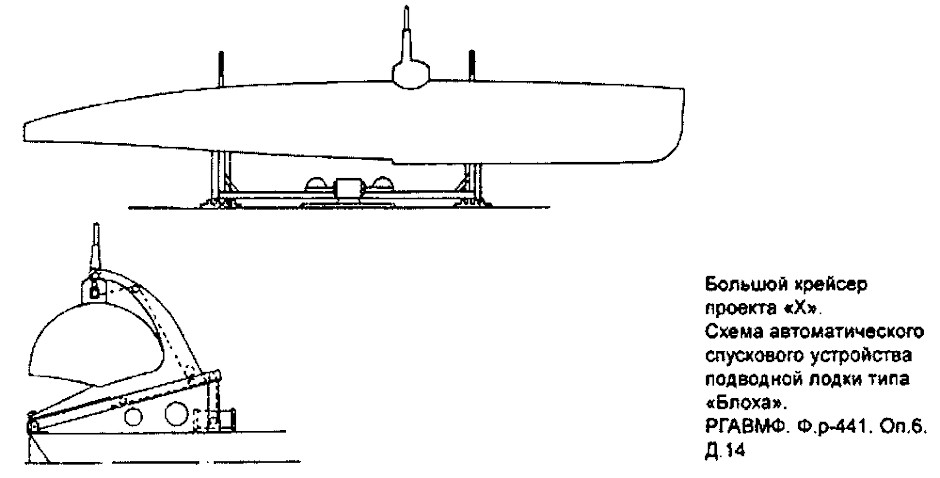
Initial project design of the “Blokha” or “Flea”, 1936. (Source: http://www.deepstorm.ru/DeepStorm.files/17-45/ns/bloha/list.html)
In 1939, another midget submarine design was submitted as the M-400 by the same designer as the Blokha, and also known as the Flea. This was a more advanced submersible torpedo boat intended to operate as either a semi-submerged torpedo boat or a full-fledged midget submarine. Information of both “Blokha” projects is currently lacking and readers are encouraged to contact the author via this website with information.
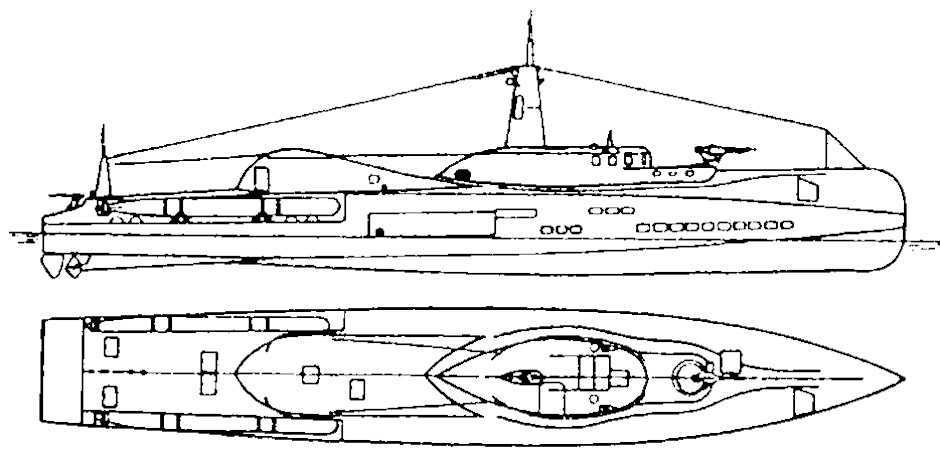
Side and dorsal view of the alleged M-400 “Blokha” submersible torpedo boat. (Source: http://www.deepstorm.ru/DeepStorm.files/17-45/ns/m400/list.html)
For additional information on the Soviet Submarine Gap, please see the following article HERE
References:
http://tonnel-ufo.ru/eanglish/weapon/submarine-submarine-pygmy.php
https://topwar.ru/155979-bespilotnye-podvodnye-lodki-stalina.html
https://svpressa.ru/war21/article/102877/
https://en.wikipedia.org/wiki/CB-class_midget_submarine
https://en.wikipedia.org/wiki/Tupolev_ANT-22
https://www.globalsecurity.org/military/world/russia/plsm.htm
https://forum.worldofwarships.com/topic/211117-soviet-large-cruiser-project-x-multipurpose-reconnaissance-heavy-cruiser-concept/
https://en.wikipedia.org/wiki/Soviet_K-class_submarine
Related articles (Full index of popular Covert Shores articles)

 Soviet Project 1015 'SPLC' Special Purpose midget submarine
Soviet Project 1015 'SPLC' Special Purpose midget submarine

 Japanese Ha201 Sen-Taka-Sho fast attack submarine of WW2
Japanese Ha201 Sen-Taka-Sho fast attack submarine of WW2

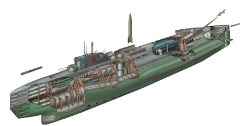 Stalin's Super Sub, Project P-2. w/Cutaway
Stalin's Super Sub, Project P-2. w/Cutaway

 WW2 German Delfin midget submarine with AIP
WW2 German Delfin midget submarine with AIP

 Mignatta first human torpedo
Mignatta first human torpedo

 Cos.Mo.S Nessie Fast SDV submersible boat
Cos.Mo.S Nessie Fast SDV submersible boat

 Japanese Ko-Hyoteki midget submarine of WW2 - Pearl Harbor attack
Japanese Ko-Hyoteki midget submarine of WW2 - Pearl Harbor attack

 Type-XXIXH stealth U-Boat. w/Cutaway
Type-XXIXH stealth U-Boat. w/Cutaway

 Project 617 'WHALE' AIP Submarine
Project 617 'WHALE' AIP Submarine

 Surcouf Cruiser Submarine w/Cutaway
Surcouf Cruiser Submarine w/Cutaway





 Nordenfelt steam powered submarines of the 1880s. w/Cutaway
Nordenfelt steam powered submarines of the 1880s. w/Cutaway

 Project 09852 Belgorod Special Mission submarine (spy sub). w/Cutaway
Project 09852 Belgorod Special Mission submarine (spy sub). w/Cutaway

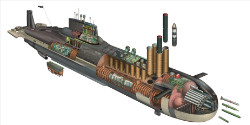 TYPHOON Class SSBN. w/Cutaway
TYPHOON Class SSBN. w/Cutaway

 Naval Spetsnaz in Hybrid Warfare (Russian SDVs and DPVs)
Naval Spetsnaz in Hybrid Warfare (Russian SDVs and DPVs)




